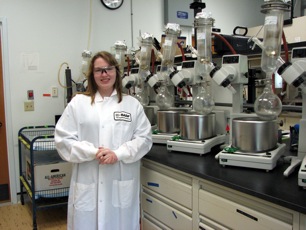IAP 2011: Chem Major Studies Agricultural Product Development
-
-
slice.mit.edu
Filed Under
Recommended
Guest blogger: Camille McAvoy '12, chemistry major Host: Mary Panek SM '67

BASF, the largest chemical company in the world, is involved in the discovery, research, and development of all kinds of chemical products ranging from crop protection compounds to catalysts to plastics and oil. During my stay at the BASF North America Crop Protection research and development site in Research Triangle Park, North Carolina, I learned—through observation, literature review, and discussion—the process through which BASF ensures that the crop protection products it produces support workers, consumers, and the environment.
For the development of agricultural products, BASF must conform to U. S. Environmental Protection Agency and Organization for Economic Co-operative Development (OECD, international) requirements for assessing the potential risk from the use of a compound. How is that risk assessed? When you have an agricultural product, whether natural or synthetic, you need to understand the toxicology, the breakdown in the environment (i.e. chemical metabolism), and the ecotoxicology of the compound and degradates.
A molecule's metabolism in the environment is affected by pH, light, microbes in the soil, and a combination of these conditions in water and sediment. Each of these areas is thoroughly studied. In addition plant metabolism, studies are performed followed by field testing on actual crops set aside for research purposes. Animal metabolism studies are conducted to assess toxicity, breakdown, and organs affected. The whole study of metabolism is accomplished using 14C radioactive labeling to track the parent molecule and its metabolites.
While at BASF, I studied these overall concepts by reviewing hydrolysis, aqueous photolysis, anaerobic and aerobic soil metabolism, and related studies looking at a particular herbicidal compound, Kixor. I observed the process of sample collection, extraction, and data collection. Such processes are meticulously documented as they are governed by Good Lab Practice (GLP) standards.
Though my time was centered in metabolism, I also had the opportunity to talk to people from a variety of departments within the agricultural products division. Mary Panek, my alumna sponsor, organized my time at BASF so that I would have the opportunity to meet with people from such departments as biological plant science, quality assurance, marketing, ecotoxicity, and regulatory. Through these interactions, I was able to acquire a more panoramic view of BASF's development process.
Although I met a variety of interesting and knowledgeable people during my stay, Mary was ultimately the one who really acted as a mentor to me, making sure not only that my days as BASF were meaningfully filled with new experiences but also that I had everything I needed in NC such as a place to stay, food, and transportation to and from the airport. Mary really established the opportunity for me to learn about BASF crop protection products.
*The postings on this site are my own and don't necessarily represent BASF's positions, strategies, or opinions.






